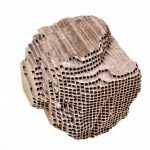Many architects use glass panels and windows to impart skyscrapers and buildings with beautiful exteriors and breathtaking, naturally lit interiors. However, this approach can also have downsides – like seriously hampering the building’s energy efficiency. Ordinary glass is transparent to the entire spectrum of solar radiation (from UV to infrared), so interiors can easily overheat, like a greenhouse. With that in mind, many architects have turned to gold for a solution.
Gold is the most malleable of all metals – so much so, that gold leaf can be beaten thin enough to become semi-transparent. Additionally, gold is also an excellent reflector of electromagnetic radiation (which includes solar radiation, visible light, and radio waves). By vacuum depositing a thin layer of gold between sheets of glass, or adding a gold nanoparticle-coating, architects can design windows that greatly limit the heat and glare of the sun.
Both the raw materials and process for making these gold glazed windows is expensive. A cheaper alternative is often used unless the building is extremely well financed or meant to make an artistic statement. Examples can be seen all around the world.
For example, the famous Sydney Opera House occupies all of Bennelong Point in Sydney Harbour, which gets full sun exposure nearly every day. Gold glazed windows were the perfect solution for keeping thousands of audience members cool while still allowing for amazing views of the harbor. The 45-story Trump International Hotel and Tower in Las Vegas also uses gold-coated windows – not just for energy efficiency, but also to match the aesthetic of the Trump brand. The Royal Bank Plaza Towers in Toronto, Canada also contain gold in all 14,000 of its windows. To create the windows, Canadian Pittsburgh Industries used 7.1 kilograms of gold. According to current gold prices, each window contains almost $230 worth of gold!











